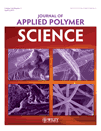Synthesis and thermal properties of phase-change microcapsules incorporated with nano alumina particles in the shell
Abstract
Novel phase-change microcapsules with paraffin as core and melamine-formaldehyde (MF) resin as shell were synthesized through in situ polymerization, in which nano alumina (nano-Al2O3) particles were dispersed in the shell by mixing nano-Al2O3 with MF prepolymer solution using the direct addition method (i.e., adding nano-Al2O3 into the MF prepolymer solution directly) and the predispersed addition method (i.e., predispersing the nano-Al2O3 homogenously in water under the assistance of dispersant and wetting agents before mixing with the MF prepolymer). Scanning electron microscope experiments demonstrated that the predispersed addition method yielded the microcapsules having the better dispersion and less self-agglomeration of alumina, compared to the direct addition method. Fourier transform infrared spectroscopy, energy dispersive X-ray spectroscopy, and electron backscatter diffraction imaging confirmed that the nano-Al2O3 particles were successfully incorporated in the shell by the predispersed addition method. The phase change behavior of microcapsules incorporated with different contents (up to 12.7% relative to the microcapsule) of nano-Al2O3 particles in the shell was investigated by differential scanning calorimeter. The results revealed that the encapsulation efficiency for this kind of novel microcapsules was >77% and the incorporation of nano-Al2O3 in the shell affected the phase change temperature. Thermal gravimetric analysis indicated that the addition of nano-Al2O3 improved the thermal stability of microcapsules remarkably. © 2011 Wiley Periodicals, Inc. J Appl Polym Sci, 2012




